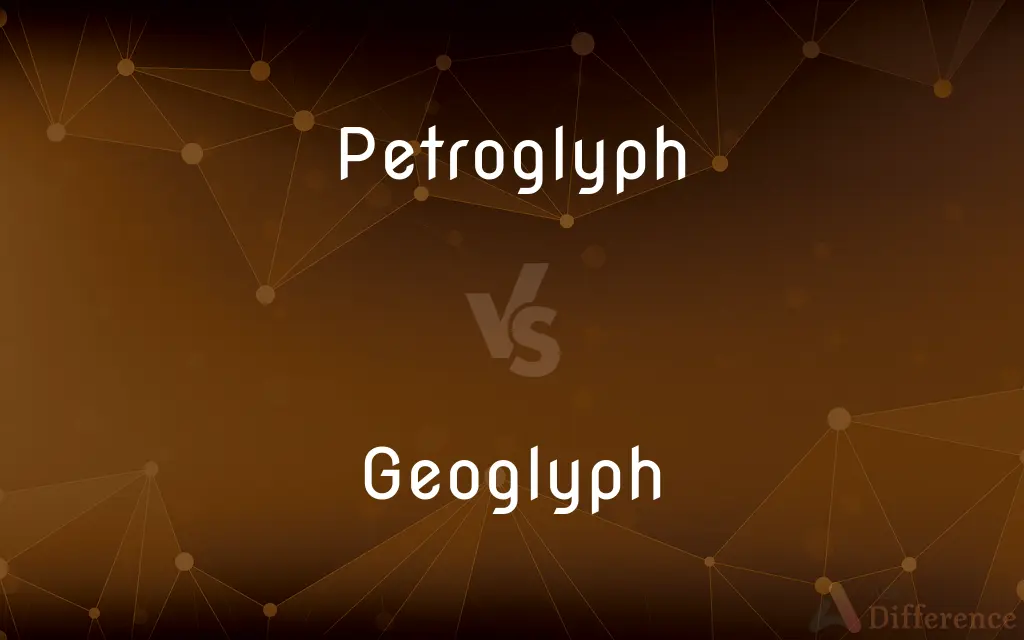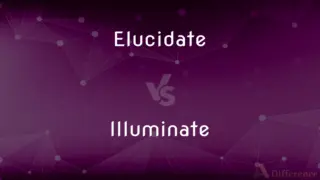Petroglyph vs. Geoglyph — What's the Difference?
By Fiza Rafique & Maham Liaqat — Updated on March 13, 2024
Petroglyphs are carvings into rock surfaces, while geoglyphs are large designs on the ground.

Difference Between Petroglyph and Geoglyph
Table of Contents
ADVERTISEMENT
Key Differences
Petroglyphs involve carving, pecking, or incising images and symbols into rock surfaces, revealing the cultural expressions of historical and prehistoric peoples. These artworks are typically found on cave walls or large stones, showcasing a range of motifs that can include humans, animals, and abstract forms. On the other hand, geoglyphs are large designs created on the ground, often by arranging stones, earth, or other materials, or by removing part of the ground surface to reveal a contrasting material below. Famous examples include the Nazca Lines in Peru, which feature large-scale representations of animals, plants, and geometric shapes, visible primarily from the air.
Both petroglyphs and geoglyphs serve as significant archaeological and cultural markers, offering insights into the beliefs, practices, and artistic expressions of past civilizations. While petroglyphs are typically smaller in scale and found on rock faces, geoglyphs cover larger areas and are constructed on the ground. This difference in scale and location reflects the diverse methods and purposes behind these ancient artworks.
The techniques used in creating petroglyphs and geoglyphs also differ. Petroglyphs are made by directly altering rock surfaces through carving or engraving, which requires tools and physical effort to chip away at the stone. Geoglyphs, however, involve the arrangement or removal of materials on the Earth's surface, which can include moving rocks, digging shallow trenches, or piling up soil to form shapes and designs.
The cultural and historical contexts of petroglyphs and geoglyphs vary widely. Petroglyphs can be found worldwide and span a vast range of time periods, from prehistoric eras to more recent historical times. Geoglyphs, while also found in various locations around the world, are often associated with specific cultures and time periods, such as the Nazca culture in South America.
The purposes and meanings behind petroglyphs and geoglyphs are often subject to interpretation and can vary significantly. Petroglyphs might represent religious or ceremonial symbols, depict scenes from daily life, or serve as boundary markers. Geoglyphs may have served astronomical, ceremonial, or navigational purposes, or could have been created as art for art's sake, with their meanings possibly changing over time.
ADVERTISEMENT
Comparison Chart
Definition
Carvings into rock surfaces.
Large designs created on the ground.
Typical Size
Smaller, individual or grouped motifs.
Larger, expansive designs.
Creation Method
Carving, pecking, incising into rock.
Arranging/removing earth or stones.
Cultural Context
Global, spanning various eras.
Often specific to a culture/time period.
Purpose/Interpretation
Varied: religious, ceremonial, boundary markers.
Also varied: astronomical, navigational, ceremonial.
Compare with Definitions
Petroglyph
An image or symbol carved into rock.
The petroglyph depicted a deer, suggesting the area's historical hunting practices.
Geoglyph
An earthwork that forms patterns or images.
The geoglyph portrayed a giant hummingbird, visible only from the sky.
Petroglyph
A form of rock art created by removing part of a rock surface.
Ancient tools were used to create the intricate petroglyphs found in the desert.
Geoglyph
A large design or motif constructed on the ground.
The geoglyphs are best appreciated from an aerial view due to their massive scale.
Petroglyph
An archaeological artifact found on cave walls or boulders.
The newly discovered petroglyphs provide insight into early human life.
Geoglyph
An ancient form of geographical expression.
The geoglyphs might have served as navigational aids for ancient peoples.
Petroglyph
A historical record of cultural symbols.
Each petroglyph represents a significant aspect of the tribe's mythology.
Geoglyph
A form of land art using natural materials.
Local stones were arranged to create the sprawling geoglyph.
Petroglyph
A prehistoric form of expression and communication.
The petroglyphs served as a form of storytelling for the indigenous tribe.
Geoglyph
A cultural landmark often associated with ancient civilizations.
The geoglyphs remain a mystery, with theories ranging from religious to astronomical purposes.
Petroglyph
A carving or incised drawing on rock, especially one made by prehistoric people.
Geoglyph
A geoglyph is a large design or motif (generally longer than 4 metres) produced on the ground by durable elements of the landscape, such as stones, stone fragments, gravel, or earth. A positive geoglyph is formed by the arrangement and alignment of materials on the ground in a manner akin to petroforms, while a negative geoglyph is formed by removing part of the natural ground surface to create differently coloured or textured ground in a manner akin to petroglyphs.
Petroglyph
A petroglyph is an image created by removing part of a rock surface by incising, picking, carving, or abrading, as a form of rock art. Outside North America, scholars often use terms such as "carving", "engraving", or other descriptions of the technique to refer to such images.
Geoglyph
A large design or drawing created on the surface of the earth, as by positioning stones or removing earth or surface rock to create lines or spaces that contrast with the surrounding terrain.
Petroglyph
A rock carving, especially a prehistoric one.
Geoglyph
A large-scale drawing or image made on the ground by arranging lines of stones, scratching the earth, etc., and often only fully visible from a distance or the air.
Crop circle
Petroglyph
(archaeology) A rock carving, especially one made in prehistoric times.
Common Curiosities
What is a petroglyph?
A petroglyph is an image or symbol carved into a rock surface as a form of ancient art or communication.
Where can petroglyphs be found?
Petroglyphs are found worldwide, on cave walls, boulders, and cliff faces.
What do petroglyphs represent?
They can represent religious or ceremonial symbols, scenes from daily life, or serve as boundary markers.
Who made petroglyphs?
Petroglyphs were made by a variety of cultures throughout history, from prehistoric peoples to more recent civilizations.
How are petroglyphs created?
Petroglyphs are made by carving, pecking, or incising designs into rock surfaces using various tools.
Where are geoglyphs typically found?
Geoglyphs are found in various parts of the world, often in desert plains or on hillsides.
Are geoglyphs only found in Peru?
No, while famous ones like the Nazca Lines are in Peru, geoglyphs exist worldwide.
What is a geoglyph?
A geoglyph is a large design or motif that is created on the ground, often visible best from an aerial perspective.
How are geoglyphs created?
Geoglyphs are made by arranging or removing stones, earth, or other materials to form patterns or designs.
What is the purpose of geoglyphs?
The purposes can vary, including astronomical, ceremonial, or navigational, or simply as art.
Are petroglyphs and geoglyphs the same?
No, petroglyphs are rock carvings, while geoglyphs are large ground designs.
Who created geoglyphs?
Geoglyphs were created by ancient civilizations, often with specific cultural or religious significance.
What materials are used to create geoglyphs?
Natural materials like rocks, earth, and sometimes vegetation are used to create geoglyphs.
Can petroglyphs provide historical insight?
Yes, they can offer insights into the cultures, beliefs, and practices of ancient peoples.
How old are the oldest petroglyphs?
Some petroglyphs date back tens of thousands of years, showing the ancient roots of human art.
Share Your Discovery

Previous Comparison
Elucidate vs. Illuminate
Next Comparison
Delighted vs. HappyAuthor Spotlight
Written by
Fiza RafiqueFiza Rafique is a skilled content writer at AskDifference.com, where she meticulously refines and enhances written pieces. Drawing from her vast editorial expertise, Fiza ensures clarity, accuracy, and precision in every article. Passionate about language, she continually seeks to elevate the quality of content for readers worldwide.
Co-written by
Maham Liaqat














































